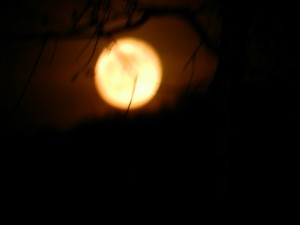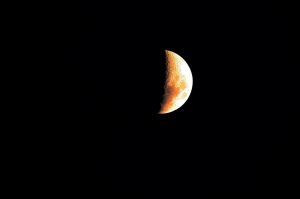It wasn’t until last Sunday evening, when I saw the yellow moon in the lavender sky that I remembered how much I liked being outside at night. I mean walking outside, without artificial lights.
Of course I’ve been out at night – but briefly: between my studio and the house, or the house and the chicken coop, and out to the car, or in the car, with headlights tunneling through the dark. But I’d stopped being outside at night, the way I’d been on the Long Trail, when living outdoors was a way of life.
On the Long Trail, Jan and I lived by daylight: up at dawn and usually (but not always) off the trail by dusk. We cooked, ate, wrote in our journals, and planned the next day’s goals by headlamp, which we used sparingly to spare battery life. Mostly, we learned to see in the dark.
It was rarely too dark to see. When there was no moon, the stars shone bright. We could perform most of our nighttime tasks with little more than the flame of the camp stove, or a brief flash of the headlamp. It doesn’t take many megawatts to wash two bowls and a pot. Brush teeth and floss in the dark? Not so hard.
I learned to love moonlight, and when the moon waned, the stars illuminated my way. One of the lessons from the Long Trail was how little artificial illumination I need outside at night. Where it’s dark, a little light goes a long way. Without blinding light pollution, a few lumens burn bright – even when beaming in from outer space.
I did need my headlamp to climb safely out of the shelter to relieve myself in the middle of the night; once outside, I could find my way by starlight to a suitable tree.
At home, the LED on my toothbrush recharger serves a beacon toward the toilet in the dark, and when I can’t sleep, constellations of LEDs from rechargers and kitchen clocks illuminate my path to the living room windows, through which I locate the moon to reorient myself to the universe.
Looking at the moon from indoors is not the same as being outside at night. Even though the dark everywhere wakens my senses, what I sense differs indoors and out.
Indoors, I feel my way across wood flooring, linoleum, wool carpet, each texture a clue to my progress. Outside, I feel the newly thawed earth give underfoot, and I smell that distinct odor of mud blooming out of the frost.
Inside, I hear the heat exchanger thrumming, giving the house breath; it’s a sound I never hear when it’s light. Outside, I hear coyotes off to the northwest, less than a mile away. In the gloaming, I catch a flash of a white tailed deer on the run. The song of the coyotes grows louder, wilder, eerie and urgent. The deer doesn’t have a chance. I turn back down the hill.
It’s dark now. Except for the moon, the planet Jupiter, and stars. At first, there are only a few stars in the sky. As it grows darker, more become visible, shining plenty of light for me to see my way home.






You will have to join me, (when I am done with this 6 month journey) at my special pond. I paddle out to watch the colors of the sunset and sit quietly to watch the moonrise. All without anything but the night glow of nature.
Usually I am embracing solitude, as I tend to set up camp during the off times.
My company is the beaver, loons frogs and of course the moon and stars.
Lights are only if by absolute necessity!
If that’s an invitation, I’m in!
Absolutely! I am just about done with my 6 month journey.
I will be home by the end of April.
Ever since I’ve been coming to Vermont, and especially since I’ve become a part-time resident of Chester, I’ve become so attuned to the night sky and maybe even a little obsessed. I’ve started writing poetry in the last year, a lot of it inspired by my alone nights in Vermont. This summer I’d like to participate in some guided star-gazing. I think there is something organized in southern Vermont, but I forget when and where. Do you happen to know anything? By the way, I hope to arrive in Vermont around May 1st and look forward to meeting you!
There’s a famous group, The Springfield Telescope Makers, and the Hartness-Porter Museum of Amateur Telescope Making. The Actual Hartness Turret Telescope (in an underground observatory) is located on the grounds or connected to the Hartness House Inn. The one time I was there, it was overcast, so no viewing. But they might be who you’re thinking of . . . Please let me know when you arrive in the Green Mountains!
Thanks, Deb!